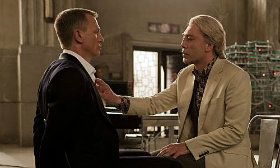 I just re-read my reviews of Casino Royale and Quantum of Solace, the first two James Bond movies starring Daniel Craig, in preparation for writing my review of the twenty-third Bond movie and third Craig installment, Skyfall. What’s interesting to me is that I loved Casino Royale, and hailed it as an exquisite “origins” tale—the “birth of Bond,” if you will—and I hated Quantum of Solace because it was too dark and brooding, with not enough Bond as we know and love him. I ended that review with the line “I want my Bond back.”
I just re-read my reviews of Casino Royale and Quantum of Solace, the first two James Bond movies starring Daniel Craig, in preparation for writing my review of the twenty-third Bond movie and third Craig installment, Skyfall. What’s interesting to me is that I loved Casino Royale, and hailed it as an exquisite “origins” tale—the “birth of Bond,” if you will—and I hated Quantum of Solace because it was too dark and brooding, with not enough Bond as we know and love him. I ended that review with the line “I want my Bond back.”
Some wishes do come true.
Skyfall lands solidly between the giddy newness of Casino Royale and the desperate broodiness of Quantum of Solace. Producers Barbara Broccoli and Michael G. Wilson learned from their mistakes with Quantum of Solace, which mostly stemmed from a wrong choice of director and a poor screenplay and rectified both, plus added something else: a look. You wouldn’t think a Bond movie could be made better by cinematography. You’d be wrong.
Director Sam Mendes (American Beauty, Revolutionary Road) brought on legendary cinematographer Roger Deakins (No Country for Old Men) and between the two of them, Skyfall has more depth and visual beauty than any previous Bond movie. Deakins’ photography not only heightens the tension, but it stunningly creates the world in which Bond is moving and we finally get a real sense of place and—even more important—meaning. I’m used to Deakins’ brilliance from the Coen Brothers movies but those stories are usually so narrow, narratively, and there isn’t much room to explore. Here, he gets to let loose with big action sequences, exotic locations and iconic characters and the master does not disappoint. A night-time Shanghai high-rise scene and a standoff in a desolate field in Scotland are just two of the memorable sequences in Skyfall that should reward Deakins with his 10th Oscar nomination (will this finally be his year for the win?).
Mendes, for his part, directs with a certain quiet elegance, which counterparts nicely with the brute force that Craig continues to bring to the role of Bond. But Craig is also very good in quiet moments and Mendes mines his seething fury to great effect. We’ve learned over the years that a Bond movie can easily be pieced together by large-scale action sequences and cheesy dialogue, but Skyfall is different. Mendes avoids the camp and the cheese completely and the action sequences actually feel relevant to the story. He focuses on character and lets the story play out naturally—and believably.
Of course, it’s still a Bond movie, which means big stunts, car chases and beautiful women. Skyfall checks off all these boxes, as it does all the other “required elements” in any Bond movie: gadgets, cars, tailored suits and exotic locales. And, of course, villains. The villain here is played with gleeful creepiness by Javier Bardem, who’s made an art out of making your skin crawl. While he keeps the scenery-chewing to a minimum, by Bond standards, Bardem is just over-the-top enough to be a classic foil. And always elegant and serious is Bond’s boss M, played with magnificence by Judi Dench. The scenes with Bardem and Dench are a real treat. Ralph Fiennes, Ben Whishaw and Albert Finney round out a stellar cast.
And I haven’t even mentioned the best part of the movie yet: the opening credit sequence. Bond movies used to have the best credit sequences. They let go of that a little bit with Casino Royale and Quantum of Solace, but the tradition is back, better than ever, with Skyfall. And the theme song, written and performed by Adele, is one of the best in the franchise’s 50-year history.
So to say Bond is back would be an understatement. Skyfall is everything you want in a Bond movie. Scratch that. Skyfall is everything you want in a movie. See it.
